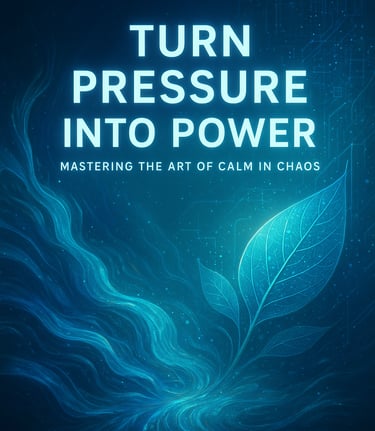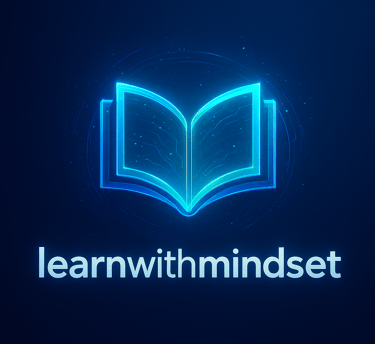
The Art of Instant Awareness – The Second That Changes Everything
There is a thin, invisible line between reaction and realization — a single second that separates unconscious living from conscious creation. It is the moment between thought and action, impulse and intention. Most people pass through this second every day without noticing it, like walking through sunlight without feeling its warmth. Yet for those who learn to see it, that single second becomes a doorway — a powerful point of awareness where life can shift completely. This is the essence of the “Seconds-Theory”: understanding that change does not begin in hours or days, but in the instant you become aware.
11/25/2025



The Art of Instant Awareness – The Second That Changes Everything
There is a thin, invisible line between reaction and realization — a single second that separates unconscious living from conscious creation. It is the moment between thought and action, impulse and intention. Most people pass through this second every day without noticing it, like walking through sunlight without feeling its warmth. Yet for those who learn to see it, that single second becomes a doorway — a powerful point of awareness where life can shift completely. This is the essence of the “Seconds-Theory”: understanding that change does not begin in hours or days, but in the instant you become aware.
We often think transformation requires grand effort — long plans, long hours, long preparation. But awareness works differently. Awareness is immediate. It is the light that appears the moment you switch on the switch. You don’t wait for it; it just happens. The same is true for the mind. When awareness arises, clarity replaces confusion in a flash. You suddenly see what you were blind to before. You realize what needs to change, what needs to stop, what needs to begin. It doesn’t take time — it takes attention. That single second of attention can change the direction of your entire life.
Think of how many times you have reacted without awareness — shouted at someone in anger, said something you didn’t mean, made a decision you later regretted. All of these happened because you lost that one second of pause. If, in that moment, you had been aware, even slightly, you could have chosen differently. You could have responded instead of reacting. That one second could have changed the next ten years. The art of instant awareness is not about slowing life down — it’s about awakening within it.
Let’s take a real-life scenario. Imagine you are in a meeting, and someone criticizes your work. The automatic mind gets defensive; your heartbeat rises, your thoughts race. You’re about to speak — but then you catch yourself. In that second, awareness steps in. You breathe, observe the emotion instead of being swallowed by it. You realize it’s not an attack but feedback. You choose calm over conflict. That’s the power of a single second of awareness. The situation didn’t change, but you did — and because of that, everything else changed too.
Awareness is not just mental; it’s energetic. It shifts your state instantly. It’s like changing the frequency on a radio — the static disappears, and suddenly you hear music. When you’re aware, your perception sharpens. The same problem looks different. The same situation feels lighter. The same person seems easier to understand. Awareness expands your vision; it removes filters built by fear, ego, and habit. In that clarity, you stop living mechanically and start living meaningfully.
The ancient sages of India called this moment “sakshi bhava” — the witness state. It’s when you observe your mind without becoming your mind. You see your thoughts come and go like clouds, but you don’t identify with them. This witnessing awareness is the highest intelligence. It doesn’t fight emotions; it sees through them. It doesn’t suppress reaction; it transforms it into response. That’s why even in ancient texts like the Upanishads, it is said: Awareness is the fire that burns ignorance instantly. The power is not in time; it’s in the present second.
Modern psychology now echoes this same truth in different words — mindfulness, cognitive reframing, emotional regulation. All these are tools to reclaim that one second between stimulus and response. Viktor Frankl once said, “Between stimulus and response, there is a space. In that space lies our power to choose our response. In our response lies our growth and our freedom.” That “space” is what this post calls “the second.” The art of instant awareness is about expanding that space — living consciously enough to see it, use it, and grow through it.
Awareness also transforms decision-making. In moments of confusion, when you don’t know what to do, awareness helps you see beyond noise. You notice the patterns of your own mind — how fear tries to rush you, how doubt tries to delay you. The aware person doesn’t suppress these voices; they listen, understand, and act from clarity, not chaos. One aware second can save years of regret. Think of how many poor decisions people make just because they don’t pause — impulsive buying, emotional quitting, harsh words, bad relationships. A single second of awareness before action can rewrite the story.
Let’s go deeper into how awareness functions. Awareness is not something to “create.” It’s always there, like the sky. What happens is that our thoughts, worries, and distractions cover it like clouds. The practice, therefore, is not to build awareness but to return to it — again and again. Every time you catch yourself lost in emotion and remember to breathe, you are returning to awareness. Every time you observe your thoughts before reacting, you are strengthening awareness. The more you practice it, the quicker it becomes. Eventually, awareness becomes reflex. You begin to live in that second permanently — alert, calm, awake.
Here’s a story. A young man once went to a master and said, “I lose my temper easily. Please help me control it.” The master said, “Go to the river, bring me a bucket of water when you are angry.” The young man was confused but obeyed. Weeks later, he returned and said, “I couldn’t do it. By the time I reached the river, my anger was gone.” The master smiled, “That’s awareness. The distance between your anger and your action dissolved it.” Awareness creates that inner distance instantly. You don’t have to walk to the river — you just have to step into the second of observation.
In daily life, the art of instant awareness can be practiced anywhere — while eating, working, speaking, even scrolling. When you are aware, you taste food instead of just consuming it. You listen to people instead of hearing words. You work with presence instead of pressure. You scroll with intention instead of addiction. Awareness turns ordinary actions into conscious experiences. That is how life transforms — not by escaping the world, but by awakening within it.
You might wonder, how can awareness really change anything if it happens in just a second? The answer lies in momentum. Every act of awareness changes your next act. When you pause once before reacting, it becomes easier to pause again next time. Awareness multiplies. Slowly, it becomes your new default. You start catching your own patterns earlier — the irritation, the judgment, the laziness — and instead of being ruled by them, you begin to rule them. It’s like catching a spark before it becomes a fire. That’s why the ancient masters called awareness the “seed of liberation.”
Awareness also brings responsibility. When you become aware, you can no longer pretend you don’t know. You see your habits, your excuses, your repetitive patterns. And that’s uncomfortable — but necessary. Because you cannot change what you do not see. Awareness is the first step to all transformation. It doesn’t require you to fix everything instantly; it simply asks you to see. Seeing is enough. Once you truly see your own behavior clearly, change becomes natural. You no longer act out of compulsion — you act out of choice.
Now, let’s talk about awareness in relationships. Most conflicts happen because people react to emotion instead of understanding it. A single second of awareness — before replying, before judging, before concluding — can save years of pain. When you are aware, you notice not just what the other person says, but also what they mean. You feel their emotion, their energy, their truth. Awareness replaces argument with empathy. It helps you see that everyone speaks from their own level of pain or peace. When you understand that, communication changes. Love deepens. Forgiveness becomes easier.
Even in the modern fast-paced digital world, instant awareness is the greatest skill you can have. When everyone is rushing, the aware person is grounded. When everyone reacts to trends, the aware person responds with intention. Awareness gives you an edge — it makes you emotionally intelligent, mentally stable, and spiritually strong. It keeps you from getting lost in the noise of opinions and helps you hear your own voice clearly. The aware person doesn’t get carried away by every wave; they become the calm beneath it.
In moments of failure, awareness reminds you that this too shall pass. In moments of success, it keeps you humble. In pain, it gives you patience. In joy, it gives you gratitude. Awareness balances the extremes. It’s the silent teacher that helps you live wisely without needing control over everything. It teaches you that you don’t need to fix life — you just need to stay awake in it.
Let’s pause for reflection. How many seconds of your day are lived consciously? When you eat, are you tasting or just chewing? When you talk, are you listening or waiting to reply? When you walk, are you present or lost in thought? Each of these is an opportunity. Every second you claim back from unconsciousness brings you closer to real peace. That’s the art of instant awareness — not doing more, but being more alive in what you already do.
The greatest masters of both Eastern and Western traditions taught this. Buddha said, “Awareness is the path to immortality.” The Stoics said, “The unexamined life is not worth living.” Both are saying the same thing — awareness is not optional; it is essential. Without it, life becomes repetition. With it, life becomes revelation.
In practical terms, awareness can start with simple practices: pause before reacting, observe before deciding, breathe before speaking. These are not small acts; they are doorways. Each pause is a sacred second — a chance to align with your higher self instead of your habits. With repetition, these moments expand, and you begin to live in a flow where life feels lighter, simpler, and more beautiful.
Eventually, you realize that awareness is not something you “use” — it’s who you are. It’s the light behind every experience. And once that realization happens, your entire perception of life changes. Problems don’t disappear, but they lose their power over you. You still feel emotions, but they no longer control you. You become both the participant and the observer of life — fully involved, yet inwardly free.
The art of instant awareness is the art of remembering yourself — again and again, second by second. It’s the moment when you stop being lost in thought and return to presence. It’s when you stop running after control and start living in clarity. It’s when you realize that peace was never missing; it was only hidden beneath the noise. And when that awareness becomes natural, you stop chasing life — you start experiencing it.
So the next time you find yourself about to react, about to rush, about to repeat an old habit — pause. One breath. One second. That’s enough. That’s where the power is. That’s where you return to yourself. And in that returning lies everything you’ve been searching for — peace, clarity, purpose, and strength. Because the truth is, you don’t need more time to change your life — you just need to wake up in the seconds you already have.
Inspiration
Empowering learners to achieve their fullest potential.
Growth
Success
© 2025. All rights reserved.
Mrs. Sadhana Ware
